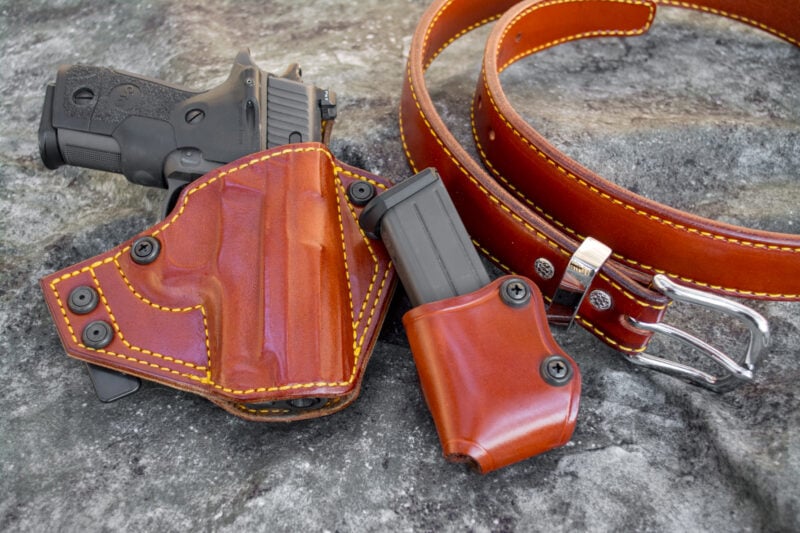Things You Learn From
The Box O' Holsters
Over the centuries, people have searched for wisdom from an odd variety of sources. The dead, elderly relatives, tea leaves, decks of cards, Ouija boards, and, more recently, crowdsourcing. That last one rests on the theory that if you get enough people to weigh in with their opinions, the truth will become evident by volume. I guess the crowdsourcing proponents have never heard of the Kardashians. Millions are attracted to that drivel, making the audience one of the largest crowds ever, but the lot of them combined likely couldn’t solve the daily Worldle with 10 guesses.
I’m aware of at least one crowdsourcing success story, however. You see, I have a crowd of holsters. Yes, I have the proverbial “box” of holsters, but also a file cabinet, lawn bag, another box, a large desk drawer and three construction dumpsters full of them. Together, they’ve generated crowdsourced wisdom and have shared some learnings with me over the years. There’s nothing quite so valuable as wisdom gained through trial, error, and failure, punctuated by the elusive success story.
So what does the Oracle of Holster have to say?
Leather is Awesome. And Sticky.
Lest I be accused of heresy, let’s get this out of the way. I love leather holsters. Craftsmanship. Feel. Performance. Elegance. Gun protection. Fine leather holsters have all these stellar attributes and more. But, like any component of your defensive gear, you’ve got to test it in all circumstances that define your yearly life.
Here’s my example. I live adjacent to a swamp. Realtors call it scenic wetlands, but you and I use the shorter word. Swamps exist where it’s hot and sticky, you know, in places like Louisiana and South Carolina. In the summer months, which last around here from March through October, you’ll sweat. And if you carry a gun using an inside-the-waistband holster, you’ll sweat even more.
One thing leather holsters have taught me is they can become somewhat sticky on the draw when things get wet. Depending on your holster design and gun frame material, you might find that butter-slick draw negatively impacted — to your detriment. On one occasion, I was running through the Air Marshal qualification course on a sweltering hot day and found my draw “error rate” skyrocketing.” My very high-end leather holster had gotten damp and very grabby, locking up my draw, especially when trying to hurry to meet the aggressive par times in this particular course of fire.
This isn’t a slam on leather. I still use it — a lot, but in the summer months, I’ll often defer to Kydex when I know I’m going to spend a lot of time out in the heat.
Loctite is Worth It
Many holsters, especially those with Kydex shells, are held together with various nut and bolt assemblies. Others might make use of one or two retention screws. If you’re regular carry rigs rely on screws for anything, you can bet with confidence they’ll work their way loose over time. I continue to be surprised at how effectively just walking around can loosen things up in a holster.
Fortunately, the fix is easy. Once you get all the adjustments right, just de-oil the screws and nuts and apply a drop of blue Loctite to the threads. Most of us do this anyway with things like optics mounts, expecting the constant movement of recoil to work things loose over time. Just give your holster the same treatment.
Beware of Floppy
Hybrid holsters make good use of different materials. For example, the backing might be leather for comfort and insulation between the body and gun, while the gun shell might be kydex for easy and inexpensive custom fit and moisture protection.
If you use such a rig, keep an eye on any sweat guard extension of the backer above the belt line. Over time, this material can soften and get floppy, potentially blocking the opening to the holster shell itself when re-holstering. That can lead to a bad day.
The remedial action for this is two-fold.
First, remember holsters have a finite shelf life. They’re not really designed to last forever, especially the leather ones. Leather softens over time, which can lead to issues like this one. When yours wears out, float it out into a nearby pond, set it on fire, and thank it for its years of faithful service. It’ll fit right in at the next feast in Valhalla.
Second, some holster designs use internal structural support to prevent this issue. For example, designs from Alien Gear, Falco Holsters, and others use sheet steel in between layers of leather to provide long-term support for the holster backing.
The Bottomline
There are plenty of other learnings from the box of holsters, but when you boil it all down, they all point back to two action items: testing and vigilance. If you test your gear over time under the same circumstances in which you might need to use it, you’ll be more likely to expose potential issues. Second, keep a close eye on the status of your gear. It won’t last forever, and as things deteriorate, performance might be at risk.
Get more exclusive online content delivered straight to your inbox. Sign up for our free American Handgunner Insider newsletter.







